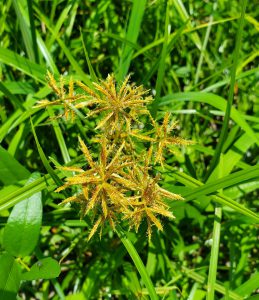
When we look at turf weeds, they generally fall into three categories – grassy weeds like Common Bermuda grass, broadleaf weeds such as dollarweed, and then there are sedges. Sedges appear almost grass-like in nature but are very different and need to be treated differently. Let’s look at the sedges commonly found in our turf and what we can do about them.
There are several common sedges in our area – most notably yellow nutsedge, purple nutsedge, globe nutsedge and various other annual and perennial types such as kyllinga. All sedges have a common look and structure. The grass-like, shiny green to yellow-green leaf blades form a clustered bunch with a stout stem emerging from the center topped with crown-like, tufted seed heads. When the flower stalk is cut in cross section, there is a distinct triangular shape that helps identify it as a sedge – remember – “sedges have edges”. Many have underground tubers and/or rhizomes that help with its sometimes-rampant propagation. Some sedges like moist conditions and their abundance may be a sign of overwatering or poor drainage. This is something to examine, especially if it can be corrected to help suppress this weed.
Mowing will not do much to suppress sedges as their growing point is below the blades. Hand-pulling has limited effectiveness as tubers or rhizomes often break off and quickly regrow. Herbicide use – both preemergence and postemergence options – depends on the type of sedge. Wait until February 1st for any preemergence application. It is a bit hot right now for the postemergence treatment – wait until temperatures are below 85 degrees F. Spot treat when you can. Always read the pesticide label as it is the law. Even with good herbicide coverage, regrowth can occur from the roots and tubers, and repeat applications may be necessary.
Sedge, whatever type it is, is not an easy weed to lick. It may take some time to suppress it to a level you can live with. As with all turf weeds, monitor regularly so that you can catch infestations while they are small. For more information on all types of weeds in our landscapes, or to ask a question, you can also call the Master Gardener Volunteer Helpdesk on Mondays, Wednesdays, and Fridays from 1 to 4 pm at 764-4340 for gardening help and insight into their role as an Extension volunteer. Ralph E. Mitchell is the Director/Horticulture Agent for UF/IFAS Extension – Charlotte County. He can be reached at 941-764-4344 or ralph.mitchell@charlottecountyfl.gov, Connect with us on social media. Like us on Facebook @CharlotteCountyExtension and follow us on Instagram @ifascharco.
Resources:
Telenko, D. E. P., Leon R., Unruh J. B., & Brecke B. J. (2019) Sedge Biology and Management in Turf. The University of Florida Extension Service, IFAS
Unruh J.B., Leon R. G., Harlow, E. E., & Trenholm L. E. (2020) Weed Management Guide for Florida Lawns. The University of Florida Extension Service, IFAS
Futch, S. H. & Hall D. W. (2020) Identification of Sedge and Sedge-Like Weeds in Florida Citrus. The University of Florida Extension Service, IFAS
Marble , C. (2019) Florida Homeowner Herbicide Guide: Considerations, Applications, and Selection. The University of Florida Extension Service, IFAS
 2
2
